low beam CADILLAC SEVILLE 1993 4.G Owners Manual
[x] Cancel search | Manufacturer: CADILLAC, Model Year: 1993, Model line: SEVILLE, Model: CADILLAC SEVILLE 1993 4.GPages: 407, PDF Size: 22.28 MB
Page 113 of 407
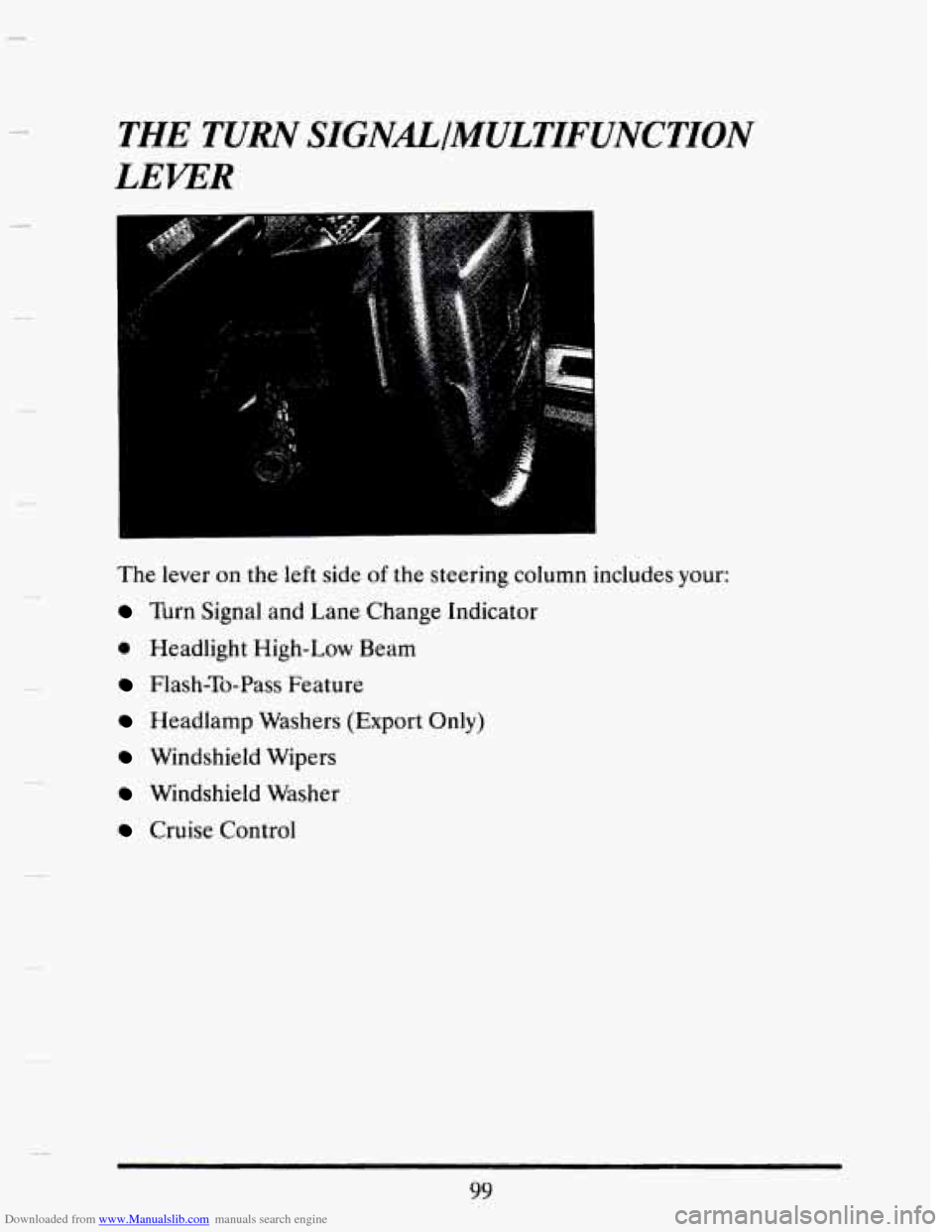
Downloaded from www.Manualslib.com manuals search engine THE TURN SIGNAL/MULTIFUNCTION
LEVER
The lever on the left side of the steering column includes your:
Turn Signal and Lane Change Indicator
0 Headlight High-Low Beam
Flash-To-Pass Feature
Headlamp Washers (Export Only)
Windshield Wipers
Windshield Washer
Cruise Control
. . ..
99
- .. ... . ... .
Page 115 of 407
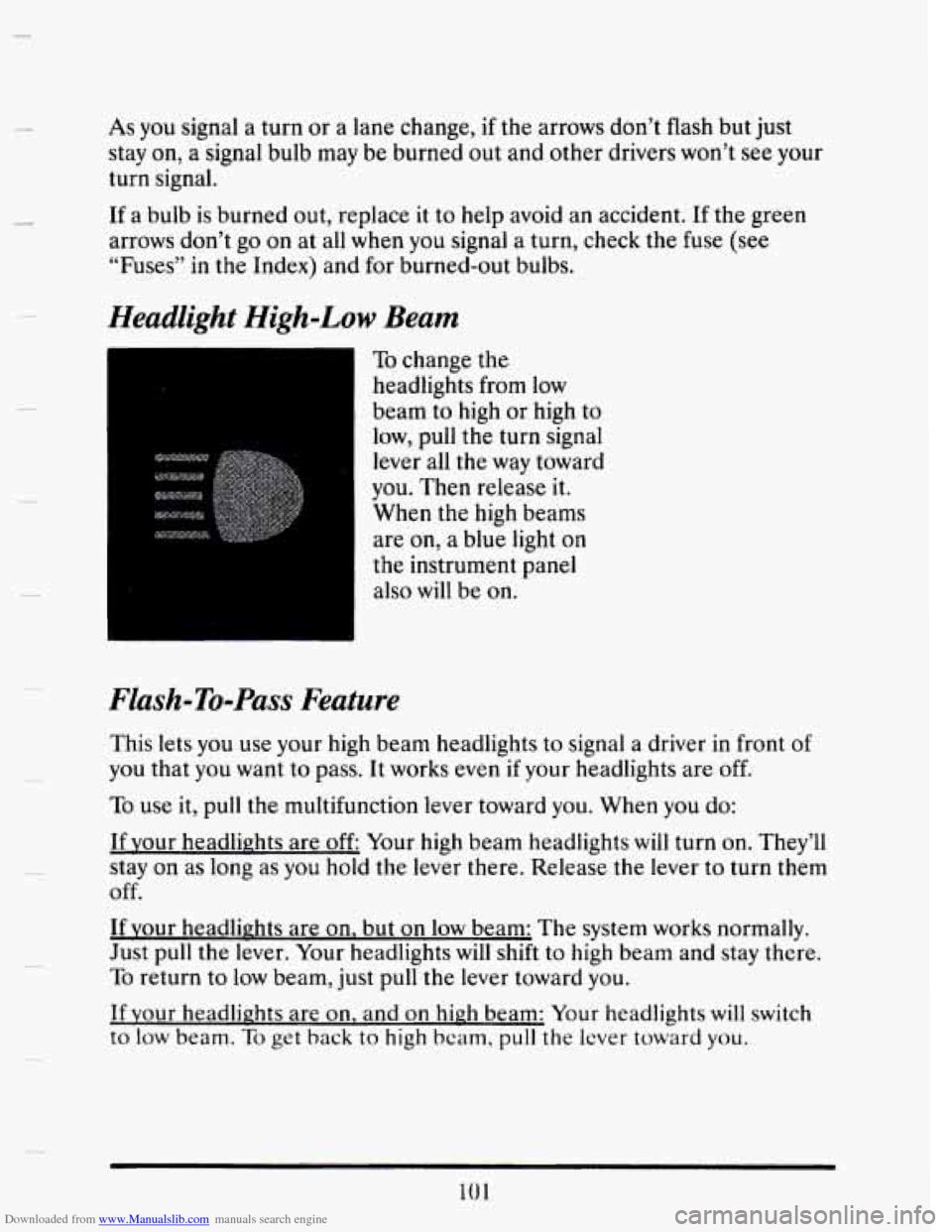
Downloaded from www.Manualslib.com manuals search engine c
As you signal a turn or a lane change, if the arrows don’t flash but just
stay
on, a signal bulb may be burned out and other drivers won’t see your
turn signal.
If a bulb is burned out, replace it to help avoid an accident. If the green
arrows don’t go on at all when you signal
a turn, check the fuse (see
“Fuses” in the Index) and for burned-out bulbs.
Headlight High-Low Beam
To change the
headlights from low
i beam to high or high to
low, pull the turn signal
lever all the way toward
you. Then release it.
When the high beams
are
on, a blue light on
the instrument panel
also will be on.
Flash-To-Pass Feature
This lets you use your high beam headlights to signal a driver in front of
you that you want to pass. It works even if your headlights are off.
To use it, pull the multifunction lever toward you. When you do:
If vour headlights are off Your high beam headlights will turn on. They’ll
stay on as long as you hold the
lever there. Release the lever to turn them
off.
If vour headlights are on, but on low beam: The system works normally.
Just pull the lever. Your headlights will shift to high beam and stay there.
To return to low beam, just pull the lever toward you.
If your headlights are on, and on high beam: Your headlights will switch
to low beam. To get back to high beam, pull the lever toward you.
10 1
Page 125 of 407
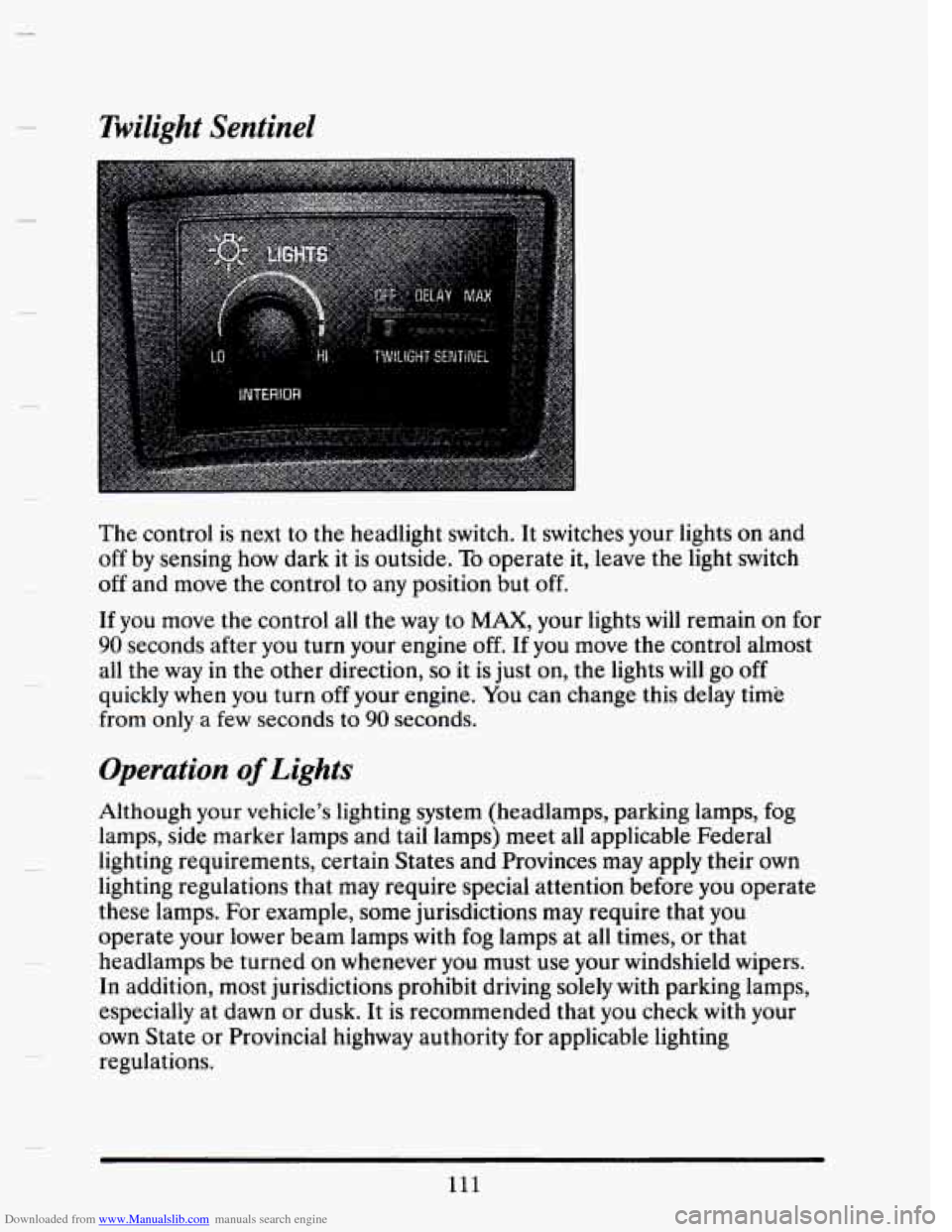
Downloaded from www.Manualslib.com manuals search engine Twilight Sentinel
I
The control is next to the headlight switch. It switches your lights on and
off by sensing how dark it is outside. To operate it, leave the light switch
off and move the control to any position but off.
If you move the control all the way to MAX, your lights will remain on for
90 seconds after you turn your engine off. If you move the control almost
all the way in the other direction,
so it is just on, the lights will go off
quickly when you turn off your engine. You can change this delay time
from
only a few seconds to 90 seconds.
Operation of Lights
Although your vehicle’s lighting system (headlamps, parking lamps, fog
lamps, side marker lamps and tail lamps) meet all applicable Federal
lighting requirements, certain States and Provinces may apply their own
lighting regulations that may require special attention before you operate
these lamps. For example, some jurisdictions may require that you
operate your lower beam lamps with fog lamps at all times, or that
headlamps be turned on whenever you must use your windshield wipers.
In addition, most jurisdictions prohibit driving solely with parking lamps,
especially at dawn or dusk.
It is recommended that you check with your
own State or Provincial highway authority for applicable lighting
regulations.
111
Page 127 of 407
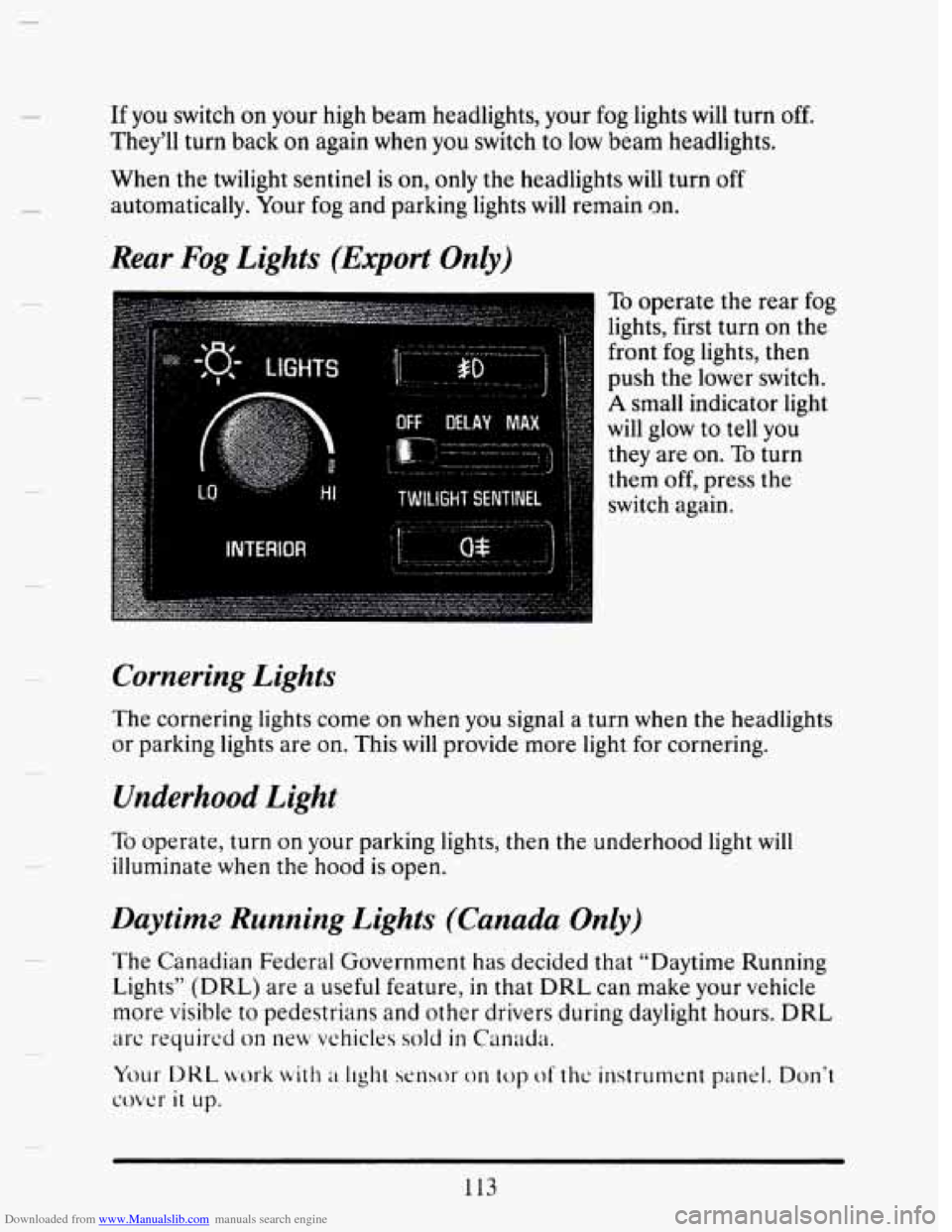
Downloaded from www.Manualslib.com manuals search engine If you switch on your high beam headlights, your fog lights will turn off.
They’ll turn back on again when you switch to low beam headlights.
When the twilight sentinel
is on, only the headlights will turn off
automatically. Your fog and parking lights will remain on.
Rear Fog Lights (Export Only)
To operate the rear fog
lights, first turn on the
front fog lights, then
push the lower switch.
A small indicator light
will glow to tell you
they are on.
To turn
them off, press the
switch again.
Cornering Lights
The cornering lights come on when you signal a turn when the headlights
or parking lights are
on. This will provide more light for cornering.
Underhood Light
To operate, turn on your parking lights, then the underhood light will
illuminate when the hood
is open.
Daytims Running Lights (Canada Only)
The Canadian Federal Government has decided that “Daytime Running
Lights” (DRL) are a useful feature,
in that DRL can make your vehicle
more visible to pedestrians and other drivers during daylight hours.
DRL
arc required on new vehicles sold in Canada.
Your DKL nw-k with ;I Ilght sensor on top of thc instrument panel. Don’t
covcr it up.
113
Page 128 of 407
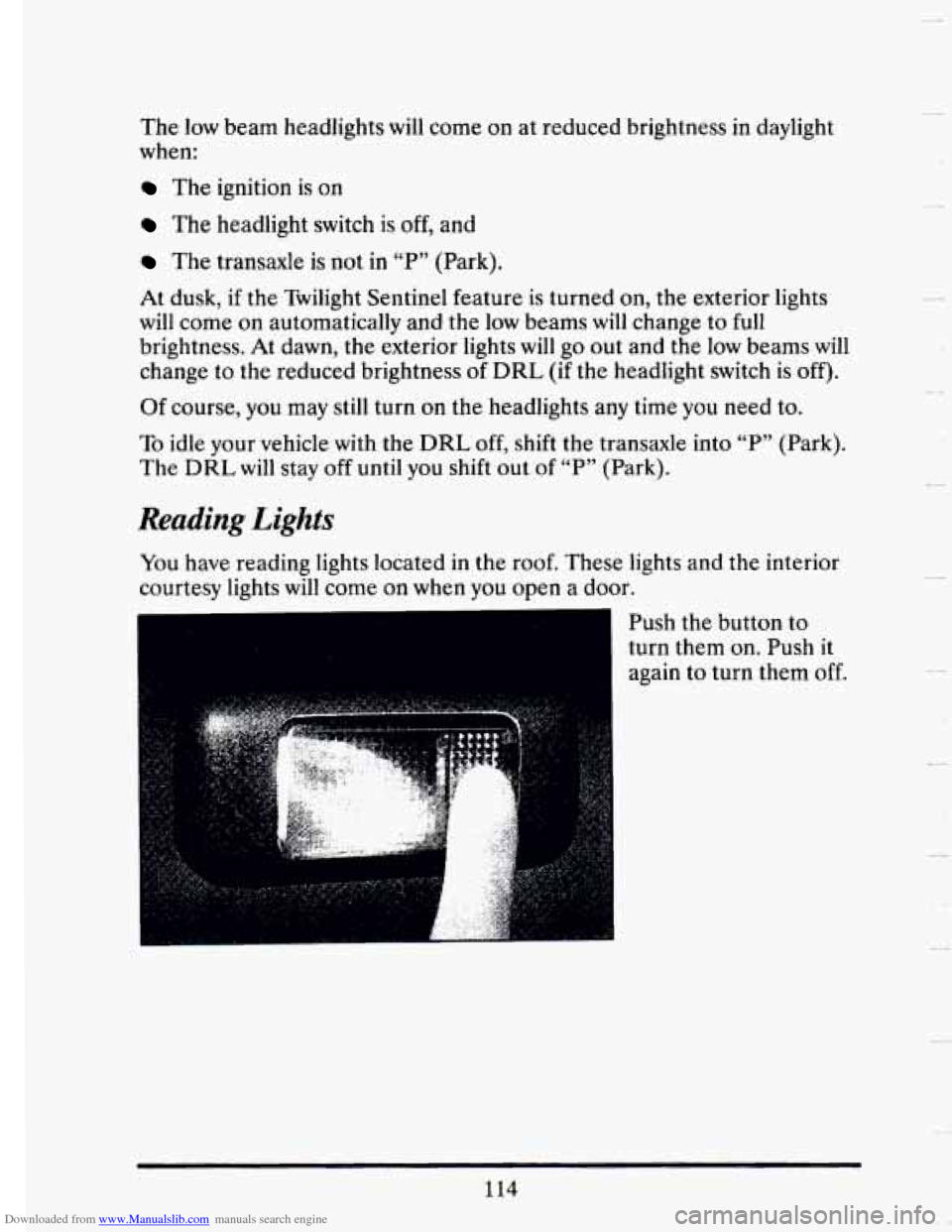
Downloaded from www.Manualslib.com manuals search engine The low beam headlights will come on at reduced brightness in daylight
when:
The ignition is on
The headlight switch is off, and
The transaxle is not in “P” (Park).
At dusk,
if the Twilight Sentinel feature is turned on, the exterior lights
will come on automatically and the low beams will change to full
brightness. At dawn, the exterior lights will
go out and the low beams will
change to the reduced brightness
of DRL (if the headlight switch is off).
Of course, you may still turn on the headlights any time you need to.
To idle your vehicle with the DRL off, shift the transaxle into “P” (Park).
The
DRL will stay off until you shift out of “P” (Park).
Reading Lights
You have reading lights located in the roof. These lights and the interior
courtesy lights will come
on when you open a door.
Push the button to turn them on. Push it
again to turn them
off.
114
Page 199 of 407

Downloaded from www.Manualslib.com manuals search engine A lot of the “driver lost control” accidents mentioned on the news
happen on curves. Here’s
why:
Experienced driver or beginner, each of us is subject to the same laws of
physics when driving on curves. The traction of the tires against the road
surface makes it possible for the vehicle to change its path
when you turn
the front wheels.
If there’s no traction, inertia will keep the vehicle going
in the same direction. If you’ve ever tried to steer a vehicle on wet ice,
you’ll understand this.
The traction
you can get in a curve depends on the condition of your tires
and the road surface, the angle at which the curve is banked, and your
speed. While you’re in a curve, speed is the one factor you can control.
Suppose you’re steering through a sharp curve. Then you suddenly
accelerate.
Those
two control systems -- steering and acceleration -- can overwhelm
those places where the tires meet the road and make you lose control.
What should you do
if this ever happens? Let up on the accelerator
pedal, steer the vehicle the
way you want it to go, and slow down.
Speed
limit signs near curves warn that you should adjust your speed. Of
course, the posted speeds are based on good weather and road
conditions. Under less favorable conditions you’ll want to
go slower.
If you need to reduce your speed as you approach a curve, do it before
you enter the curve, while your front wheels are straight ahead.
Try to adjust your speed so you can “drive” through the curve. Maintain a
reasonable, steady speed. Wait to accelerate
until you are out of the
curve, and then accelerate gently into the straightaway.
When you drive into a curve at night, it’s harder to see the road ahead of
you because
it bends away from the straight beams of your lights. This is
one good reason to drive slower.
Steering in Emergencies
There are times when steering can be more effective than braking. For
example, you come over a
hill and find a truck stopped in your lane, or a
car suddenly pulls out from nowhere,
or a child darts out from between
parked cars and stops right
in front of you. You can avoid these problems
185
Page 205 of 407
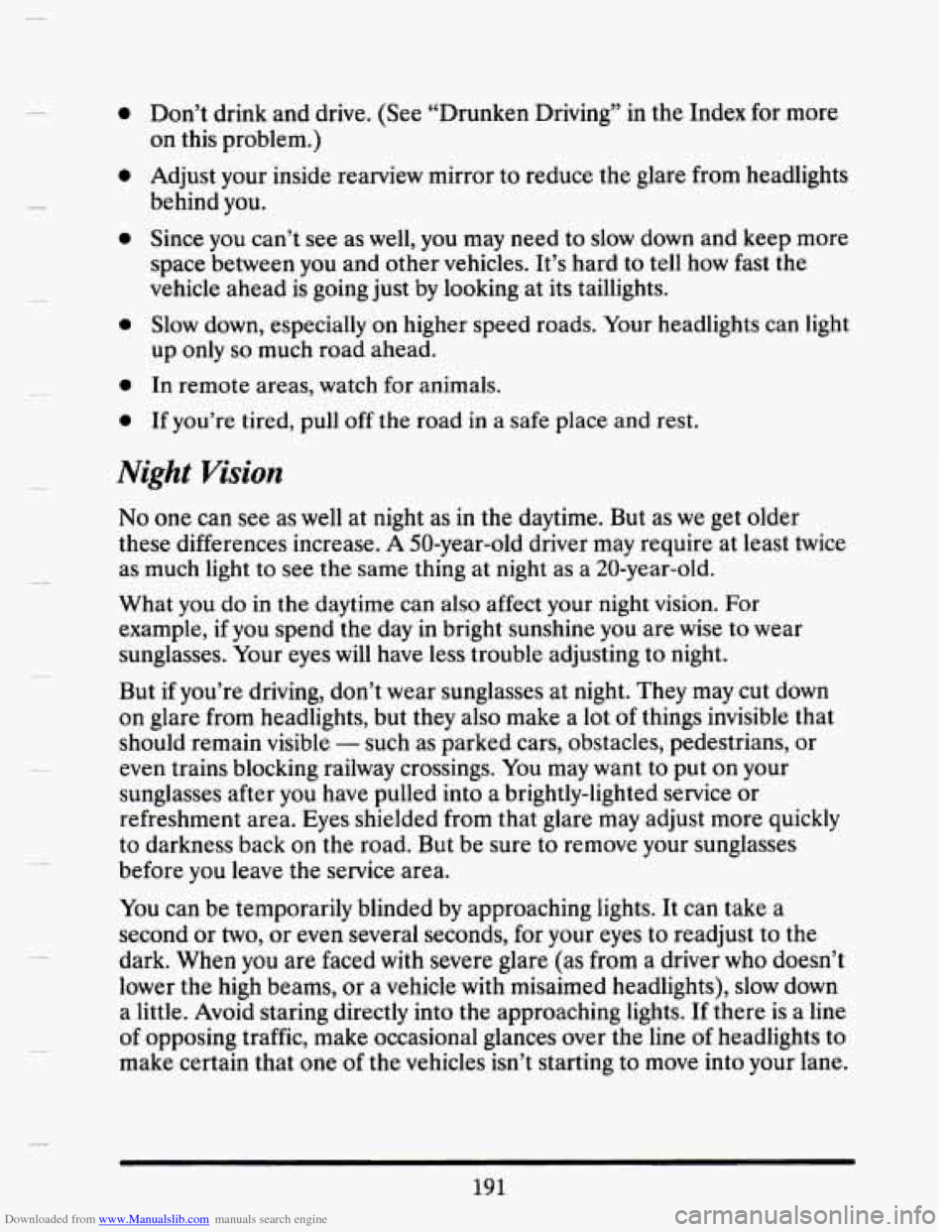
Downloaded from www.Manualslib.com manuals search engine 0
0 0
0
0
Don’t drink and drive. (See “Drunken Driving” in the Index for more
on this problem.)
Adjust your inside rearview mirror to reduce the glare from headlights
behind
you.
Since you can’t see as well, you may need to slow down and keep more
space between you and other vehicles. It’s hard to tell how fast the
vehicle ahead is going just by looking at its taillights.
Slow down, especially on higher speed roads. Your headlights can light
up only
so much road ahead.
In remote areas, watch for animals.
If you’re tired, pull off the road in a safe place and rest.
Night Vision
No one can see as well at night as in the daytime. But as we get older
these differences increase. A 50-year-old driver may require at least twice
as much light to see the same thing at night as a 20-year-old.
What you
do in the daytime can also affect your night vision. For
example, if you spend the day in bright sunshine you are wise to wear
sunglasses. Your eyes
will have less trouble adjusting to night.
But
if you’re driving, don’t wear sunglasses at night. They may cut down
on glare from headlights, but they also make a lot
of things invisible that
should remain visible
- such as parked cars, obstacles, pedestrians, or
even trains blocking railway crossings. You may want to put on your
sunglasses after you have pulled into a brightly-lighted service or
refreshment area. Eyes shielded from that glare may adjust more quickly
to darkness back
on the road. But be sure to remove your sunglasses
before you leave the service area.
You can be temporarily blinded by approaching lights. It can take a
second
or two, or even several seconds, for your eyes to readjust to the
dark. When
you are faced with severe glare (as from a driver who doesn’t
lower the high beams, or a vehicle with misaimed headlights), slow down
a little. Avoid staring directly into the approaching lights. If there is a line
of opposing traffic, make occasional glances over the line
of headlights to
make certain that
one of the vehicles isn’t starting to move into your lane.
191
Page 206 of 407
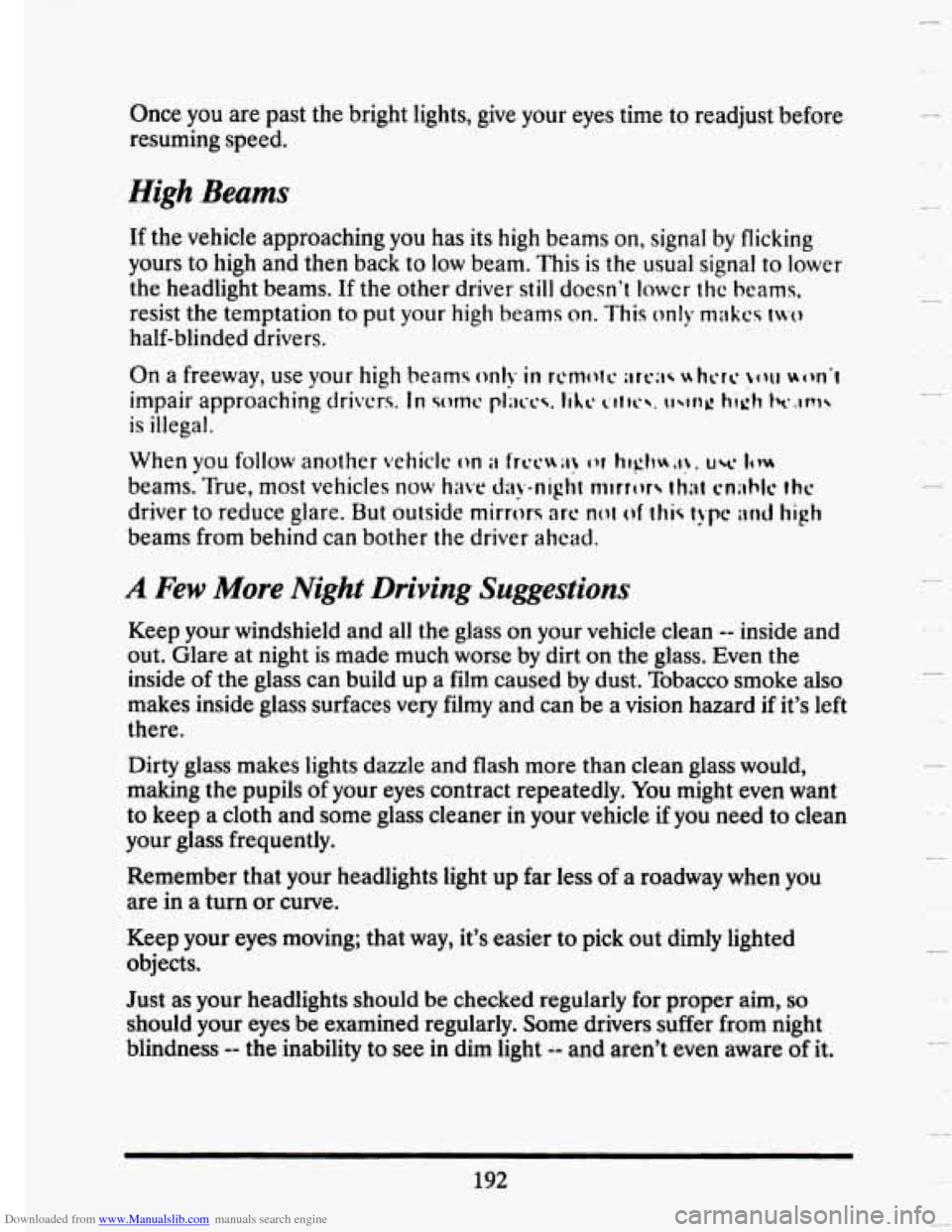
Downloaded from www.Manualslib.com manuals search engine Once YOU are past the bright lights, give your eyes time to readjust before
resuming speed.
High Beams
If the vehicle approaching you has its high beams on, signal by flicking
yours to high and
then back to low beam. This is the usual signal to lower
the headlight beams. If the other driver still doesn't lowcr thc beams,
resist the temptation to put your high beams on. This only makcs two
half-blinded drivers.
When you follow another
vehiclc on ii Irt'CHiI! or h1gh;n. uw I(VH
beams. True, most vehicles now have d;wnight mirror that cn;rblc rhc
driver to reduce glare. But outside mirrbrs arc' not of thi< typc i\d high
beams from behind can bother the driver ahcad.
A Few More Night Driving Suggestions
Keep your windshield and all the glass on your vehicle clean -- inside and
out. Glare at night is made much worse
by dirt on the glass. Even the
inside
of the glass can build up a film caused by dust. Tobacco smoke also
makes inside glass surfaces
very filmy and can be a vision hazard if it's left
there.
Dirty glass makes lights dazzle and flash more than clean glass would,
making the pupils
of your eyes contract repeatedly. You might even want
to keep a cloth and some glass cleaner
in your vehicle if you need to clean
your glass frequently.
Remember that your headlights light up far less
of a roadway when you
are in
a turn or curve.
Keep your eyes moving; that way, it's easier to pick out dimly lighted
objects.
Just as your headlights should be checked regularly for proper aim, so
should your eyes be examined regularly. Some drivers suffer from night
blindness
-- the inability to see in dim light -- and aren't even aware of it,
192
Page 211 of 407
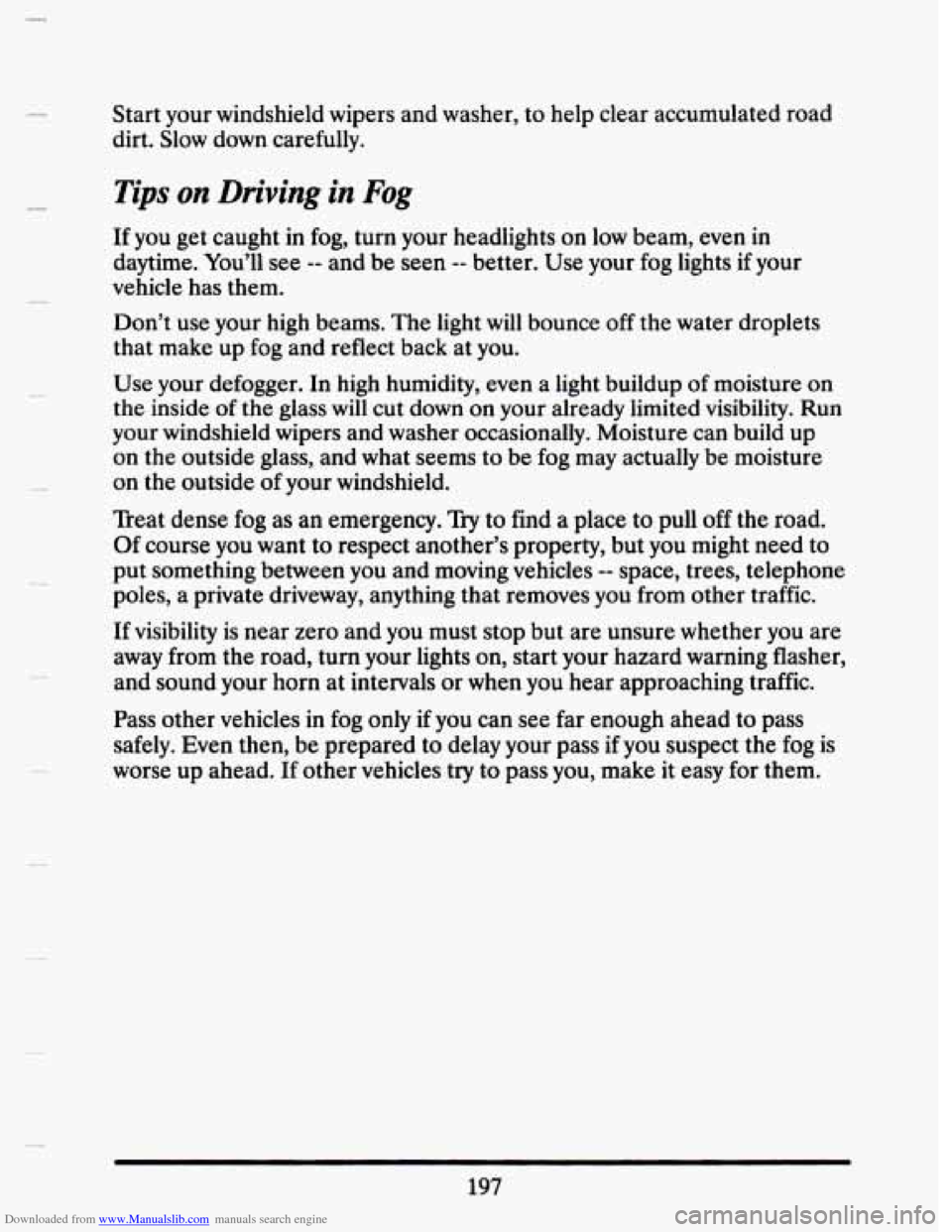
Downloaded from www.Manualslib.com manuals search engine Start your windshield wipers and washer, to help clear accumulated road
dirt. Slow down carefully.
Tips on Driving in Fog
If you get caught in fog, turn your headlights on low beam, even in
daytime. You’ll
see -- and be seen -- better. Use your fog lights if your
vehicle has them.
Don’t use your high beams. The light will bounce
off the water droplets
that make up fog and reflect back at you.
Use your defogger. In high humidity, even a light buildup of moisture
on
the inside of the glass will cut down on your already limited visibility. Run
your windshield wipers and washer occasionally. Moisture can build up
on the outside glass, and what seems
to be fog may actually be moisture
on the outside of your windshield.
Treat dense fog as an emergency.
Try to find a place to pull off the road.
Of course you want to respect another’s property, but you might need to
put something between
you and moving vehicles -- space, trees, telephone
poles,
a private driveway, anything that removes you from other traffic.
If visibility is near zero and you must stop but are unsure whether you are
away from the road, turn your lights on, start your hazard warning flasher,
and sound your horn at intervals or when you hear approaching traffic.
Pass other vehicles in fog
only if you can see far enough ahead to pass
safely. Even then, be prepared to delay your pass
if you suspect the fog is
worse up ahead.
If other vehicles try to pass you, make it easy for them.
197
Page 343 of 407
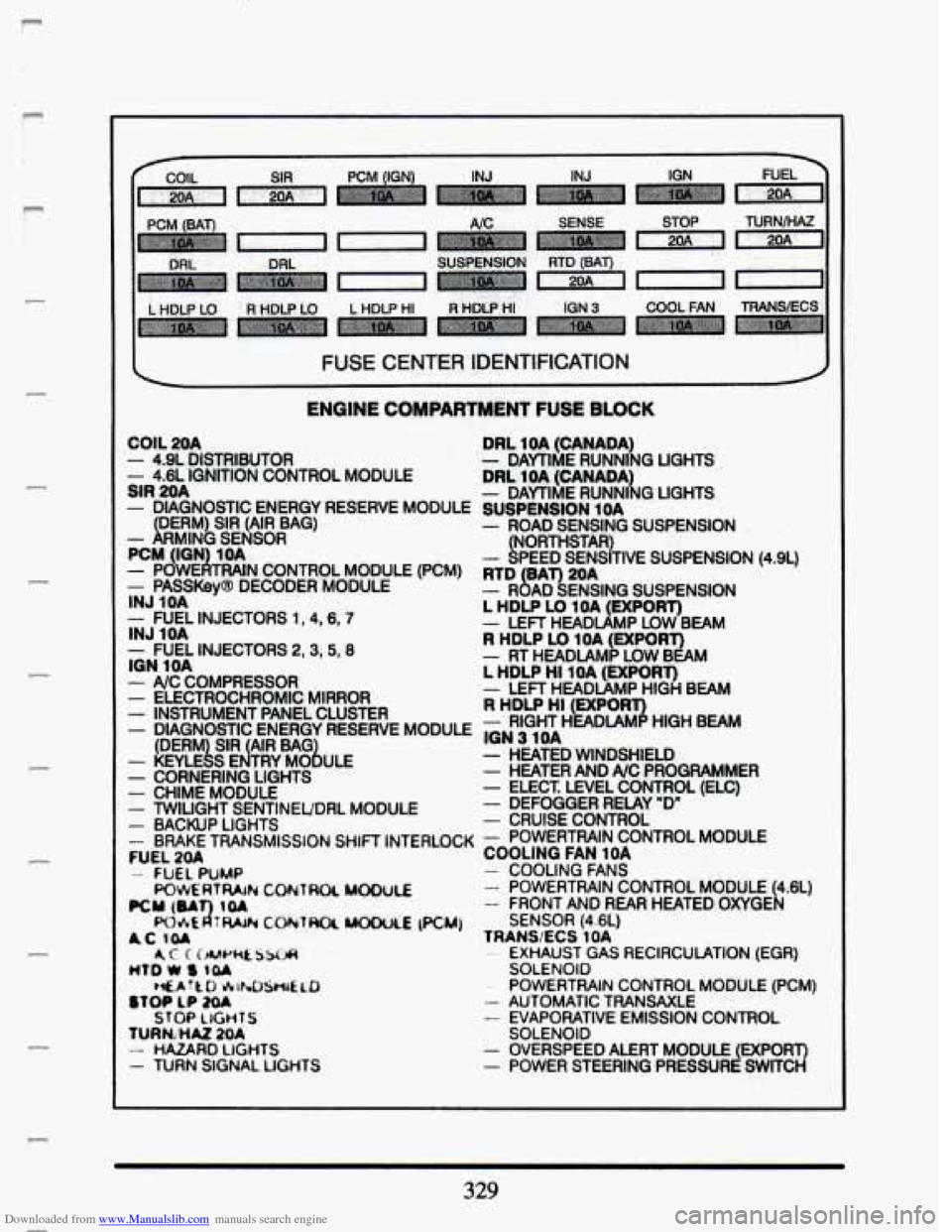
Downloaded from www.Manualslib.com manuals search engine c
P
___.__ HDIP Lo HDLP HI R H'C HI IGN 3 COOL FAN TRANSECS
i I
I FUSE CENTER IDENTIFICATION J
ENGINE COMPARTMENT FUSE BLOCK
COIL 20A - 4.9L DISTRIBUTOR - 4.6L IGNtTION CONTROL MODULE SIR 2OA
- DIAGNOSTIC ENERGY RESERVE - - - - - - -
LF4 DERM) SIR (AIR BAG) - MlNG SENSOR
PCM (IO 1.OA - POWE Y TRAIN CONTROL MODUL
INJ IOA - PASSKeyS DECODER MODULE MODULE
.E (PCM)
--FUEL INJECTORS 1,4,6,7 INJ 1OA - FUEL INJECTORS 2,3,5,8 ION 1OA - A/C COMPRESSOR - ELECTROCHROMIC MIRROR - INSTRUMENT PANEL CLUSTER - DIAGNOSTIC ENERGY RESERVE MODULE
- KEYLE &Pi S E TRY MO b ULE - CORNERING LIGHTS - CHIME MODULE - TWILIGHT SENTINEUDRL MODULE - BACKUP LIGHTS - BRAKE TRANSMISSION SHIFT INTERLOCK
- FUEL PUMP
(DERM SIR AIR BAG
FUEL
20A
PCU(&A IOA
AC IOI
MID W 8 101
$TOP LP ;Ku
fURNiHA2 20A
FQWERTWN CONTROL MOWlE
MI&€ a 7RAIFI CONTRO( uOMKE (PCM)
AC CCEUYellS3uA
HfArtO &NISH&AO
STOP LIGHTS
- HAZARD LIGHTS - TURN SIGNAL LIGHTS
DRL 1OA (CANADA)
DRL
10A (CANADA)
SUSPENSION 1OA
- DAYTIME RUNNING LIGHTS
- DAYTIME RUNNING LIGHTS
- ROAD SENSING SUSPENSION
- LNORTHSTW PEED SENSITIVE SUSPENSION (4.9L)
- R 6 AD SENSING SUSPENSION
- LEFT HEADIAMP LOW BEAM
- RT HEADLAMP LOW BEAM
- LEFT HEADIAMP HIGH BEAM
- RIGHT HEADIAMP HIGH BEAM
- HEATED WINDSHIELD - HEATER AND A/C PROGRAMMER
- ELECT. LEVEL CONTROL (ELC) - DEFOGGER RELAY "D"
- CRUISE CONTROL
- POWERTRAIN CONTROL MODULE
- COOLING FANS
- POWERTRAIN CONTROL MODULE 4.6L)
- FRONT AND REAR HEATED OXYGE L
RTD BAT) 20A
L HDLP LO 1OA (EXPORT)
R HDLP LO 1OA (EXPORT)
L HDLP HI 1OA (EXPORT)
R HDLP HI (EXPORT)
ION 3 1OA
COOLING FAN 1OA
SENSOR (4.6L) TRANSIECS 1 OA
SOLENOID -- EXHAUST GAS RECIRCULATION (EGR)
- POWERTRAIN CONTROL MODULE (PCM) - AUTOMATIC TRANSAXLE - EVAPORATIVE EMISSION CONTROL
- OVERSPEED ALERT MODULE (EXPOR
- POWER STEERING PRESSURE SWITC 3
SOLENOID
329
I
F